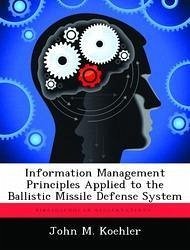
Information Management Principles Applied to the Ballistic Missile Defense System
Versandkostenfrei!
Versandfertig in über 4 Wochen
15,99 €
inkl. MwSt.

PAYBACK Punkte
8 °P sammeln!
Information systems (IS) have evolved over the last 50 plus years from individual components with single functionality to grand architectures that integrate multiple individual business functions into global organizational enterprises. Similarly several military systems with the single mission of missile defense have evolved in service stovepipes, and are now being integrated into a national and global missile defense architecture. The Missile Defense Agency (MDA) is currently tasked with developing an integrated Ballistic Missile Defense System (BMDS) capable of defending against all ranges o...
Information systems (IS) have evolved over the last 50 plus years from individual components with single functionality to grand architectures that integrate multiple individual business functions into global organizational enterprises. Similarly several military systems with the single mission of missile defense have evolved in service stovepipes, and are now being integrated into a national and global missile defense architecture. The Missile Defense Agency (MDA) is currently tasked with developing an integrated Ballistic Missile Defense System (BMDS) capable of defending against all ranges of ballistic missiles in all phases of flight in defense of the homeland, our deployed forces, and our allies. While this initiative has been proceeding since before Ronald Reagan's Strategic Defense Initiative, the full momentum has only recently been achieved through the withdrawal of the Anti-Ballistic Missile Treaty and demonstrated threats from North Korea and Iran. This study draws parallels between the evolution of IS and the BMDS. Further it compiles information management (IM) principles, investigates if they apply to the BMDS, and investigates if they can be used to achieve a better integrated system. Initial indications are that IM principles do apply, but it is questionable if they are being applied. This work has been selected by scholars as being culturally important, and is part of the knowledge base of civilization as we know it. This work was reproduced from the original artifact, and remains as true to the original work as possible. Therefore, you will see the original copyright references, library stamps (as most of these works have been housed in our most important libraries around the world), and other notations in the work. This work is in the public domain in the United States of America, and possibly other nations. Within the United States, you may freely copy and distribute this work, as no entity (individual or corporate) has a copyright on the body of the work. As a reproduction of a historical artifact, this work may contain missing or blurred pages, poor pictures, errant marks, etc. Scholars believe, and we concur, that this work is important enough to be preserved, reproduced, and made generally available to the public. We appreciate your support of the preservation process, and thank you for being an important part of keeping this knowledge alive and relevant.












